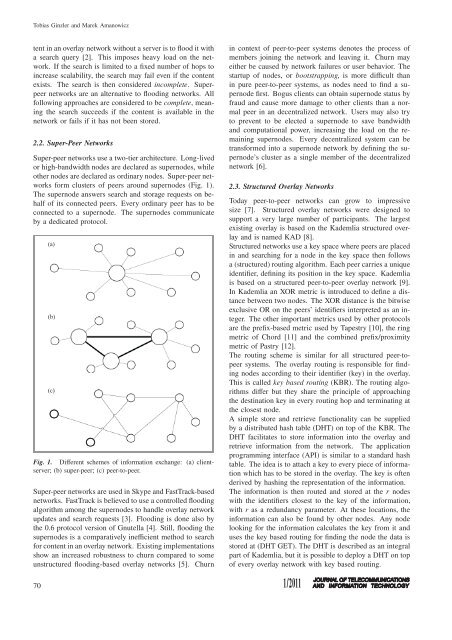Adaptation of the Kademila Routing for Tactical Networks
Adaptation of the Kademila Routing for Tactical Networks
Adaptation of the Kademila Routing for Tactical Networks
Create successful ePaper yourself
Turn your PDF publications into a flip-book with our unique Google optimized e-Paper software.
Tobias Ginzler and Marek Amanowicz<br />
tent in an overlay network without a server is to flood it with<br />
a search query [2]. This imposes heavy load on <strong>the</strong> network.<br />
If <strong>the</strong> search is limited to a fixed number <strong>of</strong> hops to<br />
increase scalability, <strong>the</strong> search may fail even if <strong>the</strong> content<br />
exists. The search is <strong>the</strong>n considered incomplete. Superpeer<br />
networks are an alternative to flooding networks. All<br />
following approaches are considered to be complete, meaning<br />
<strong>the</strong> search succeeds if <strong>the</strong> content is available in <strong>the</strong><br />
network or fails if it has not been stored.<br />
2.2. Super-Peer <strong>Networks</strong><br />
Super-peer networks use a two-tier architecture. Long-lived<br />
or high-bandwidth nodes are declared as supernodes, while<br />
o<strong>the</strong>r nodes are declared as ordinary nodes. Super-peer networks<br />
<strong>for</strong>m clusters <strong>of</strong> peers around supernodes (Fig. 1).<br />
The supernode answers search and storage requests on behalf<br />
<strong>of</strong> its connected peers. Every ordinary peer has to be<br />
connected to a supernode. The supernodes communicate<br />
by a dedicated protocol.<br />
Fig. 1. Different schemes <strong>of</strong> in<strong>for</strong>mation exchange: (a) clientserver;<br />
(b) super-peer; (c) peer-to-peer.<br />
Super-peer networks are used in Skype and FastTrack-based<br />
networks. FastTrack is believed to use a controlled flooding<br />
algorithm among <strong>the</strong> supernodes to handle overlay network<br />
updates and search requests [3]. Flooding is done also by<br />
<strong>the</strong> 0.6 protocol version <strong>of</strong> Gnutella [4]. Still, flooding <strong>the</strong><br />
supernodes is a comparatively inefficient method to search<br />
<strong>for</strong> content in an overlay network. Existing implementations<br />
show an increased robustness to churn compared to some<br />
unstructured flooding-based overlay networks [5]. Churn<br />
in context <strong>of</strong> peer-to-peer systems denotes <strong>the</strong> process <strong>of</strong><br />
members joining <strong>the</strong> network and leaving it. Churn may<br />
ei<strong>the</strong>r be caused by network failures or user behavior. The<br />
startup <strong>of</strong> nodes, or bootstrapping, is more difficult than<br />
in pure peer-to-peer systems, as nodes need to find a supernode<br />
first. Bogus clients can obtain supernode status by<br />
fraud and cause more damage to o<strong>the</strong>r clients than a normal<br />
peer in an decentralized network. Users may also try<br />
to prevent to be elected a supernode to save bandwidth<br />
and computational power, increasing <strong>the</strong> load on <strong>the</strong> remaining<br />
supernodes. Every decentralized system can be<br />
trans<strong>for</strong>med into a supernode network by defining <strong>the</strong> supernode’s<br />
cluster as a single member <strong>of</strong> <strong>the</strong> decentralized<br />
network [6].<br />
2.3. Structured Overlay <strong>Networks</strong><br />
Today peer-to-peer networks can grow to impressive<br />
size [7]. Structured overlay networks were designed to<br />
support a very large number <strong>of</strong> participants. The largest<br />
existing overlay is based on <strong>the</strong> Kademlia structured overlay<br />
and is named KAD [8].<br />
Structured networks use a key space where peers are placed<br />
in and searching <strong>for</strong> a node in <strong>the</strong> key space <strong>the</strong>n follows<br />
a (structured) routing algorithm. Each peer carries a unique<br />
identifier, defining its position in <strong>the</strong> key space. Kademlia<br />
is based on a structured peer-to-peer overlay network [9].<br />
In Kademlia an XOR metric is introduced to define a distance<br />
between two nodes. The XOR distance is <strong>the</strong> bitwise<br />
exclusive OR on <strong>the</strong> peers’ identifiers interpreted as an integer.<br />
The o<strong>the</strong>r important metrics used by o<strong>the</strong>r protocols<br />
are <strong>the</strong> prefix-based metric used by Tapestry [10], <strong>the</strong> ring<br />
metric <strong>of</strong> Chord [11] and <strong>the</strong> combined prefix/proximity<br />
metric <strong>of</strong> Pastry [12].<br />
The routing scheme is similar <strong>for</strong> all structured peer-topeer<br />
systems. The overlay routing is responsible <strong>for</strong> finding<br />
nodes according to <strong>the</strong>ir identifier (key) in <strong>the</strong> overlay.<br />
This is called key based routing (KBR). The routing algorithms<br />
differ but <strong>the</strong>y share <strong>the</strong> principle <strong>of</strong> approaching<br />
<strong>the</strong> destination key in every routing hop and terminating at<br />
<strong>the</strong> closest node.<br />
A simple store and retrieve functionality can be supplied<br />
by a distributed hash table (DHT) on top <strong>of</strong> <strong>the</strong> KBR. The<br />
DHT facilitates to store in<strong>for</strong>mation into <strong>the</strong> overlay and<br />
retrieve in<strong>for</strong>mation from <strong>the</strong> network. The application<br />
programming interface (API) is similar to a standard hash<br />
table. The idea is to attach a key to every piece <strong>of</strong> in<strong>for</strong>mation<br />
which has to be stored in <strong>the</strong> overlay. The key is <strong>of</strong>ten<br />
derived by hashing <strong>the</strong> representation <strong>of</strong> <strong>the</strong> in<strong>for</strong>mation.<br />
The in<strong>for</strong>mation is <strong>the</strong>n routed and stored at <strong>the</strong> r nodes<br />
with <strong>the</strong> identifiers closest to <strong>the</strong> key <strong>of</strong> <strong>the</strong> in<strong>for</strong>mation,<br />
with r as a redundancy parameter. At <strong>the</strong>se locations, <strong>the</strong><br />
in<strong>for</strong>mation can also be found by o<strong>the</strong>r nodes. Any node<br />
looking <strong>for</strong> <strong>the</strong> in<strong>for</strong>mation calculates <strong>the</strong> key from it and<br />
uses <strong>the</strong> key based routing <strong>for</strong> finding <strong>the</strong> node <strong>the</strong> data is<br />
stored at (DHT GET). The DHT is described as an integral<br />
part <strong>of</strong> Kademlia, but it is possible to deploy a DHT on top<br />
<strong>of</strong> every overlay network with key based routing.<br />
70

















